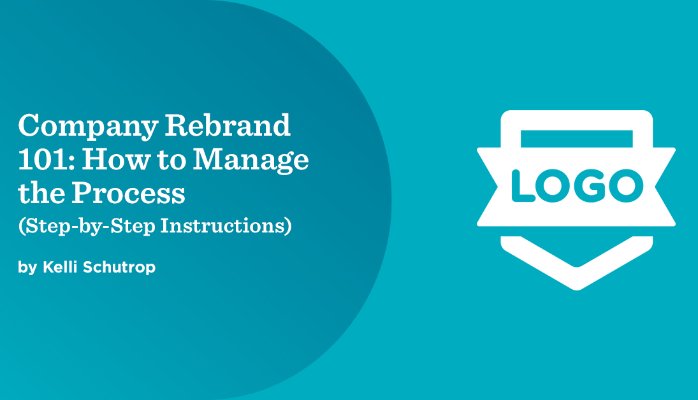
A good brand has power. It transcends its product or service. It symbolizes something greater to people. But what happens if a brand isn’t achieving your company’s vision? What if things change so much that your existing brand doesn’t make sense anymore?Rebranding is common – healthy, in fact! Managing a company rebrand, however, comes with its own set of challenges. To help navigate this exciting, and sometimes difficult-to-maneuver process, see below for a step-by-step guide.
Why Rebrand?
There are many reasons a company chooses to rebrand. Leading this process starts with a clear understanding of “the why.” Here are the most common reasons for a rebrand:
- Ownership Change or Restructure: This can include mergers, splits, or leadership changes. A brand is commonly up for review when executives or board members make these types of decisions.
- Reposition: Think Old Spice, the deodorant brand. The company has been around since 1937. It recently launched the Old Spice Man campaign (also known as “The Man Your Man Could Smell Like”) to make an appeal to those wanting to be sexy and desirable. If the company brand stayed the way it was in 1937, it likely wouldn’t see the attention and revenue success it now experiences. Most businesses that rebrand because of repositioning do so to appeal to a different audience or to further promote a particular product or service. That said, it’s very challenging (and expensive!) for a large established company to rebrand which is why Old Spice is such a great example. It’s much easier to reposition at an earlier product stage, and with a more nimble company.
- Expand Internationally: When introducing a brand to another country that speaks another language, research is vital. Check out some of these brands-gone-international failures. Rough. And quite entertaining!
- Improve Reputation: Sometimes companies or products need a makeover after taking a hit to their reputation. While suffering from a negative perception is never ideal, taking charge of it with a rebrand may be the best way to recover.
- Stay Relevant or Simplify: Apple has been around since 1976. People initially knew the tech icon as Apple Computer Company. Not only did it drop “Computer Company” from its name, but it has also undergone a number of logo redesigns over the years – each simpler than the previous.
The Process of Rebranding
After you understand the purpose, you can define the process. Here is a five-step approach.
1. Know Your Vision, Plan for Results
As famous productivity guru, Stephen Covey, says – begin with the end in mind.
- Vision: Though you may not have the complete picture, having a clear vision of the rebrand will help you make all the little decisions along the way. Whenever you’re stuck, it’s a good idea to take a step back. Refocus on your vision, and ask yourself if the next step will bring you closer to, or further away from that vision.
- Results: The other element of perception is knowing the results you expect once you achieve the vision. Do you anticipate being more relevant to women in their 20s? How will you measure that? Make sure there is agreement on what the outcome will be and how to judge the success of it.
2. Define Key Stakeholders
It’s important to know your key stakeholders at the outset. These are the people who will be affected by the rebrand. They can be both internal and external. Here’s a list of examples:
Internal:
- Leadership Team
- Board Members
- Investors
- Employees
External:
- Key Clients
- Clients
- Potential Clients
- The Market/General Public (publications, organizations you’re a part of, audiences you can reach through PR efforts, etc.)
3. Establish a Communication Plan
Once you’ve defined the key stakeholders, put together a communication plan. Create a spreadsheet with the suggested column titles below to keep track of how you plan to promote the change and various aspects of the process:
- Key Stakeholder (Column A) – E.g., Employees
- Message or Information Needed (Column B) – E.g., Key message about the rebrand – why it’s happening, what it will accomplish, the timeline, and the necessary information to share with clients
- Delivery Method (Column C) – E.g., All-company meeting led by CEO; division meetings for further Q&A led by Marketing Manager; email from Marketing Manager providing marketing collateral and talking points for their client conversations
- Frequency (Column D) – E.g., Once in company meeting; once in division meetings; once in email
- Date (Column E) – E.g., ____ months/weeks before rebrand launch
- Responsible for Communication (Column F) – E.g., Company CEO to host all-company meeting; Marketing Manager to create marketing collateral and host division meetings
Grab the latest discounts on Adidas items when you use our special Radio Formula cupones. Show off your look and save big with this offer today!
4. Create a Project Timeline
Create a timeline, and stick to it. A simple spreadsheet will do if you don’t have project management software. Not only will a timeline keep you on track, but it will also help you remember to share information with the right people at the appropriate phases. Here are some suggested column titles and examples for this spreadsheet:
- Phases – E.g., Develop Key Message, Develop Communications Plan, Communicate to All Audiences, Communicate to Market, Back Office Tasks
- Internal Team – E.g., List the names of the individuals or teams participating in each phase
- Stakeholders – E.g., List the key stakeholder affected by each phase
- Calendar – E.g., Add one column for each week in the project. Highlight the corresponding row(s) to visually define the length each phase will take. Note that some phases may only be one square (one week) while others may span the length of the rebrand
5. Design the Ultimate Project Plan
This final element of this process is the ability to stay the course. In other words, stick to the Project Plan. Use this spreadsheet as the ultimate keep-you-on-schedule, don’t-forget-anything tool. Different from the communications plan and project timeline, this spreadsheet includes all of the little details and has color-coding for easy-to-read status checks. Use these recommended column titles and examples to get started:
- Type of Activity – E.g., Communication; Branding; Website; Legal/Internal Process
- Description – E.g., Develop Key Message; Create email template for communication to clients; Employee voicemail updates
- Point Person – E.g., List the individual who will handle making sure this gets accomplished
- Participants – E.g., List any other individuals needed to accomplish the task, such as if you need a leadership team approval or a web developer to make changes to the website
- Status – E.g., (This is the color-coded part!) Red for “Not yet started” – Yellow for “In process” – Green for “Completed”
- Due Date – E.g., Date
- Dependencies – E.g., List any tasks that need to happen before this task. For example, you will need to create the Key Messaging prior to sending communication out to the clients. Another example would be that you need to have the rebranding launch (via a press release or other means) before your employees can announce it on social media
- Notes – E.g., Anything else you think would be helpful to remember
Plan for the Unexpected
There will be things that come up along the way that you never anticipated. Here are a couple areas to keep an eye on.
1. Inventory your current brand presence
This includes all of the places your existing brand, logo, and identifiable assets live. Your brand is likely in more places than you even realize. To get started, consider the following: email signatures, voicemails, company on-hold music, building signage, marketing collateral, online presence (website, social media, Google/SEO), employee’s language (answering the phone, sales pitches), and more.
2. Anticipate Budget Spend
Rebranding costs money, therefore, getting a handle on the project cost is critical. Create budget estimates as you go through your Project Plan. Consider the following:
- Design fees for logo, website, email signatures, marketing collateral, advertising, etc.
- Printing fees for marketing collateral, building signage, etc.
- Promotional items (in-house) such as mugs, pens, etc.
- Promotional items (client-facing) such as trade show tablecloth, banners, stress balls, other giveaways, etc.
- PR services (anything from hiring a PR agency to submitting a press release on the wire)
- Website design and development
- SEO services to promote your new brand
Post-Rebrand
You’ve launched the new brand! Now what? For one, pat yourself on the back – this is a major accomplishment! Following your happy dance, it’s important to give yourself space to recap what went well, what could have gone better, and what lessons you learned along the way.
If you have a hard time stopping to evaluate how the project went, reserve a conference room for 30 minutes and lock yourself in it with a notebook. Ask yourself – Did I accomplish my goal? Did I communicate with all my audiences in a way that worked? What went well? What could have gone better?
Once you’ve answered these questions, get a few key stakeholders in the room to ask them the same. Business owners and leaders quickly move from one focus to the next without pausing, so get feedback from them while you still have their attention. You’ll also want their reflection on how well the rebrand achieved the agreed upon outcomes. If the project didn’t turn out the way everyone envisioned, determine why, how to fix it, and what you can do moving forward to make sure you have successful initiatives in the future.
Reform of the current law, written in 2019 and improved last April, is currently being debated in Congress and has certainly not gone unnoticed: industry giants, including the Swiss, are covertly pushing clomid online for a rejection of the proposed changes to the law.

